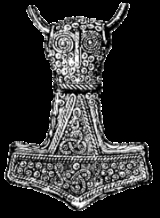
Mjolnir
Encyclopedia
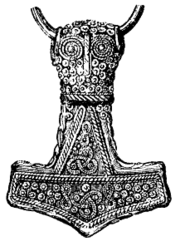
Norse mythology
Norse mythology, a subset of Germanic mythology, is the overall term for the myths, legends and beliefs about supernatural beings of Norse pagans. It flourished prior to the Christianization of Scandinavia, during the Early Middle Ages, and passed into Nordic folklore, with some aspects surviving...
, Mjölnir (icon or ˈ ; also Mjǫlnir, Mjollnir, Mjölner or Mjølner) is the hammer of Thor
Thor
In Norse mythology, Thor is a hammer-wielding god associated with thunder, lightning, storms, oak trees, strength, the protection of mankind, and also hallowing, healing, and fertility...
, a major god associated with thunder in Norse mythology
Norse mythology
Norse mythology, a subset of Germanic mythology, is the overall term for the myths, legends and beliefs about supernatural beings of Norse pagans. It flourished prior to the Christianization of Scandinavia, during the Early Middle Ages, and passed into Nordic folklore, with some aspects surviving...
. Distinctively shaped, Mjölnir is depicted in Norse mythology as one of the most fearsome weapons, capable of leveling mountains. Though generally recognized and depicted as a hammer, Mjölnir is sometimes referred to as an axe or club. In the 13th century Prose Edda
Prose Edda
The Prose Edda, also known as the Younger Edda, Snorri's Edda or simply Edda, is an Icelandic collection of four sections interspersed with excerpts from earlier skaldic and Eddic poetry containing tales from Nordic mythology...
, Snorri Sturluson relates that the Svartálfar
Svartálfar
In Norse mythology, svartálfar are beings who dwell in Svartálfaheimr . Both the svartálfar and Svartálfaheimr are solely attested in the Prose Edda, written in the 13th century by Snorri Sturluson...
Sindri, the brother of Brokkr, made Mjöllnir while in a contest with Loki
Loki
In Norse mythology, Loki or Loke is a god or jötunn . Loki is the son of Fárbauti and Laufey, and the brother of Helblindi and Býleistr. By the jötunn Angrboða, Loki is the father of Hel, the wolf Fenrir, and the world serpent Jörmungandr. By his wife Sigyn, Loki is the father of Nari or Narfi...
to see who could make the most wonderful and useful items for the Gods and Goddesses in Asgard
Asgard
In Norse religion, Asgard is one of the Nine Worlds and is the country or capital city of the Norse Gods surrounded by an incomplete wall attributed to a Hrimthurs riding the stallion Svadilfari, according to Gylfaginning. Valhalla is located within Asgard...
The Prose Edda
Prose Edda
The Prose Edda, also known as the Younger Edda, Snorri's Edda or simply Edda, is an Icelandic collection of four sections interspersed with excerpts from earlier skaldic and Eddic poetry containing tales from Nordic mythology...
gives a summary of Mjölnir's special qualities in that, with Mjölnir, Thor:
... would be able to strike as firmly as he wanted, whatever his aim, and the hammer would never fail, and if he threw it at something, it would never miss and never fly so far from his hand that it would not find its way back, and when he wanted, it would be so small that it could be carried inside his tunic.
Etymology
Mjölnir simply means "crusher", referring to its pulverizing effect. Mjölnir might be related to the Russian word молния (molniya) and the Welsh word mellt (both words being translated as "lightning"). This second theory parallels with the idea that ThorThor
In Norse mythology, Thor is a hammer-wielding god associated with thunder, lightning, storms, oak trees, strength, the protection of mankind, and also hallowing, healing, and fertility...
, being a god of thunder, therefore might have used lightning as his weapon.
It is related to words such as the Icelandic verbs mölva ("to crush") and mala ("to grind"), and Swedish
Swedish language
Swedish is a North Germanic language, spoken by approximately 10 million people, predominantly in Sweden and parts of Finland, especially along its coast and on the Åland islands. It is largely mutually intelligible with Norwegian and Danish...
noun mjöl ("flour"), all related to English meal, mill, and miller. Similar words, all stemming from the Proto-Indo-European root *melə, can be found in almost all European languages, e.g. the Slavic melevo ("grain to be ground") and molot ("hammer"), the Russian Молот (molot—"hammer"), the Greek μύλος (mylos—"mill"), the Spanish moler ("to grind"), and the Latin malleus "hammer", from which English mallet derives, as well as the Latin mola ("mill").
Prose Edda
The most popular version of the creation of Mjölnir myth, found in SkáldskaparmálSkáldskaparmál
The second part of Snorri Sturluson's Prose Edda the Skáldskaparmál or "language of poetry" is effectively a dialogue between the Norse god of the sea, Ægir and Bragi, the god of poetry, in which both Norse mythology and discourse on the nature of poetry are intertwined...
from Snorri's Edda, is as follows. In one story Loki sends up to the dwarves called the Sons of Ivaldi
Sons of Ivaldi
In Norse mythology, the Sons of Ivaldi are a group of dwarfs who fashion Skidbladnir, the ship of Freyr, and the Gungnir, the spear of Odin, as well as golden hair for Sif to replace what Loki had cut off....
that create precious items for the gods: Odin's spear Gungnir
Gungnir
In Norse mythology, Gungnir is the spear of the god Odin.-Poetic Edda:In the Poetic Edda poem Völuspá, the Æsir-Vanir War is described as officially starting when Odin throws a spear over the heads of an assembly of Vanir gods. Whether or not this was specifically Gungnir is, however, unstated...
, and Freyr
Freyr
Freyr is one of the most important gods of Norse paganism. Freyr was highly associated with farming, weather and, as a phallic fertility god, Freyr "bestows peace and pleasure on mortals"...
's foldable boat Skíðblaðnir
Skíðblaðnir
In Norse mythology, Skíðblaðnir is the best of ships. Skíðblaðnir is attested in the Poetic Edda, compiled in the 13th century from earlier traditional sources, and in the Prose Edda and Heimskringla, both written in the 13th century by Snorri Sturluson...
. Then Loki bets his head that the two Dwarves, Sindri (or Eitri
Eitri
In Norse mythology, Eitri is a dwarf and the brother of Brokkr.According to Skáldskaparmál, when Loki had Sif's hair, Freyr's ship Skidbladnir and Odin's spear Gungnir fashioned by the Sons of Ivaldi, he bet his own head with Brokkr that Eitri would not have been able to make items that matched...
) and his brother Brokkr would never succeed in making items more beautiful than those of Ivaldi's sons. The bet is accepted and the two brothers begin working. Thus Eitri puts a pig's skin in the forge and tells his brother (Brokkr) never to stop blowing until he comes and takes out what he put in.
Loki, in disguise as a fly, comes and bites Brokkr on the arm but he continues to blow. Then Eitri takes out Gullinbursti
Gullinbursti
Gullinbursti is a boar in Norse mythology.When Loki had Sif's hair, Freyr's ship Skíðblaðnir and Odin's spear Gungnir fashioned by the Sons of Ivaldi, he bet his own head with Brokkr that his brother Eitri wouldn't have been able to make items to match the quality of those mentioned above.So to...
which is Freyr's
Freyr
Freyr is one of the most important gods of Norse paganism. Freyr was highly associated with farming, weather and, as a phallic fertility god, Freyr "bestows peace and pleasure on mortals"...
boar with shining bristles. Then Eitri puts some gold in the furnace and gives Brokkr the same order. Loki in the fly guise comes again and bites Brokkr's neck twice as hard. But as before nothing happens and Eitri takes out Draupnir
Draupnir
In Norse mythology, Draupnir is a gold ring possessed by the god Odin with the ability to multiply itself: Every ninth night eight new rings 'drip' from Draupnir, each one of the same size and weight as the original....
, Odin's ring, having duplicates falling from itself every ninth night
Numbers in Norse mythology
The numbers three and nine are significant numbers in Norse mythology and paganism. Both numbers appear throughout surviving attestations of Norse paganism, in both mythology and cultic practice....
.
Eitri then puts iron in the forge and tells Brokkr to never stop blowing. Loki comes again and bites Brokkr on the eyelid much harder than before and the blood makes him stop blowing for a short while. When Eitri comes and takes out Mjöllnir, the handle is a bit short (making it one handed). Eitri and Brokkr win the bet, which was Loki's head. However, the bet cannot be honoured, since they need to cut the neck as well, which was not part of the deal. As a result, Brokkr sews Loki's mouth to teach him a lesson.
Poetic Edda
Thor possessed a formidable chariot, which is drawn by two goats, Tanngrisnir and TanngnjóstrTanngrisnir and Tanngnjóstr
Tanngrisnir and Tanngnjóstr are the goats who pull the god Thor's chariot in Norse mythology...
. A belt, Megingjörð, and iron gloves, Járngreipr
Járngreipr
In Norse mythology, Járngreipr or Járnglófi are the iron gloves of the god Thor. According to the Prose Edda, along with the hammer Mjölnir and the belt Megingjörð, Járngreipr is one of Thor's three crucial possessions. According to chapter 20 of the book Gylfaginning, Thor uses the gloves to...
, were used to lift Mjölnir. Mjölnir is the focal point of some of Thor's adventures.
This is clearly illustrated in a poem found in the Poetic Edda
Poetic Edda
The Poetic Edda is a collection of Old Norse poems primarily preserved in the Icelandic mediaeval manuscript Codex Regius. Along with Snorri Sturluson's Prose Edda, the Poetic Edda is the most important extant source on Norse mythology and Germanic heroic legends, and from the early 19th century...
titled Þrymskviða
Þrymskviða
Þrymskviða is one of the best known poems from the Poetic Edda...
. The myth relates that the giant, Þrymr, steals Mjölnir from Thor and then demands the goddess Freyja in exchange. Loki
Loki
In Norse mythology, Loki or Loke is a god or jötunn . Loki is the son of Fárbauti and Laufey, and the brother of Helblindi and Býleistr. By the jötunn Angrboða, Loki is the father of Hel, the wolf Fenrir, and the world serpent Jörmungandr. By his wife Sigyn, Loki is the father of Nari or Narfi...
, the god notorious for his duplicity, conspires with the other Æsir
Æsir
In Old Norse, áss is the term denoting a member of the principal pantheon in Norse paganism. This pantheon includes Odin, Frigg, Thor, Baldr and Tyr. The second pantheon comprises the Vanir...
to recover Mjölnir by disguising Thor as Freyja and presenting him as the "goddess" to Þrymr.
At a banquet Þrymr holds in honor of the impending union, Þrymr takes the bait. Unable to contain his passion for his new maiden with long, blond locks (and broad shoulders), as Þrymr approaches the bride by placing Mjölnir on "her" lap, Thor rips off his disguise and destroys Þrymr and his giant cohorts.
Emblemic pendants
Myths, artifacts, and institutions revolving around Thor indicate his prominent place in the mind of medieval Scandinavians. His following ranged in influence, but the Viking warrior aristocracy were particularly inspired by Thor's ferocity in battle. In the medieval legal arena, according to Joseph CampbellJoseph Campbell
Joseph John Campbell was an American mythologist, writer and lecturer, best known for his work in comparative mythology and comparative religion. His work is vast, covering many aspects of the human experience...
, "And at the Icelandic Things
Thing (assembly)
A thing was the governing assembly in Germanic and introduced into some Celtic societies, made up of the free people of the community and presided by lawspeakers, meeting in a place called a thingstead...
(court assemblies) the god invoked in testimony of oaths, as 'the Almighty God,' was Thor."
Emblematic of their devotion were the appearance of miniature replicas of Mjöllnir, widely popular in Scandinavia.
Many of these replicas were also found in graves and tended to be furnished with a loop, allowing them to be worn. Mjölnir amulets were most widely discovered in areas with a strong Christian influence including southern Norway, south-eastern Sweden, and Denmark. Due to the similarity of equal-armed, square crosses featuring figures of Christ on them at around the same time, the wearing of Thor's hammers as pendants may have come into fashion in defiance of the square amulets worn by newly converted Christians in the regions.
The shape taken by these pendants varied by region. The Icelandic variant was cross-shaped, while Swedish and Norwegian variants tended to be arrow or T
T
T is the 20th letter in the basic modern Latin alphabet. It is the most commonly used consonant and the second most common letter in the English language.- History :Taw was the last letter of the Western Semitic and Hebrew alphabets...
-shaped.
About 50 specimens of such hammers were found widely dispersed throughout Scandinavia, dating from the 9th to 11th centuries.
A few such examples were also found in England. An iron Thor's hammer pendant excavated in Yorkshire, dating to ca. AD 1000 bears an unical inscription preceded and followed by a cross, interpreted as indicating a Christian owner syncretizing pagan and Christian symbolism.
A 10th century soapstone mold found at Trendgården, Jutland
Jutland
Jutland , historically also called Cimbria, is the name of the peninsula that juts out in Northern Europe toward the rest of Scandinavia, forming the mainland part of Denmark. It has the North Sea to its west, Kattegat and Skagerrak to its north, the Baltic Sea to its east, and the Danish–German...
, Denmark is notable for allowing the casting of both crucifix and Thor's hammer pendants. A silver specimen found near Fossi, Iceland (now in the National Museum of Iceland
National Museum of Iceland
The National Museum of Iceland was established on 24 February 1863, with Jón Árnason the first curator of the Icelandic collection, previously kept in Danish museums...
) can be interpreted as either a Christian cross or a Thor's hammer. Unusually, the elongated limb of the cross ends in a beast's (perhaps a wolf's) head.
A precedent of these Viking Age Thor's hammer amulets are recorded for the migration period Alemanni, who took to wearing Roman "Hercules' Clubs
Hercules' Club (amulet)
Hercules' Club is a Roman Empire and Migration era artefact type.Roman era Hercules's Clubs appear from the 2nd to 3rd century, spread over the empire Hercules' Club (also Hercules-club, Club-of-Hercules; German ) is a Roman Empire and Migration era artefact type.Roman era Hercules's Clubs...
" as symbols of Donar. A possible remnant of these Donar amulets was recorded in 1897, as a custom of Unterinn (South Tyrolian Alps) of incising a T-shape above front doors for protection against evils of all kinds, especially storms.
Stones
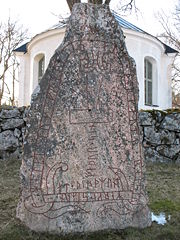
Altuna Runestone
The Altuna Runestone , listed as U 1161 in the Rundata catalog, is a Viking Age memorial runestone with images from Norse mythology that is located in Altuna, Uppland, Sweden.- Description :...
in Altuna, Sö 86
Södermanland Runic Inscription 86
thumb|300px|right|A drawing of runic inscription Sö 86 published in 1876.Sö 86 is the Rundata catalog number for a Viking Age memorial runic inscription located in Åby, Södermanland, Sweden...
in Åby, Sö 111
Stenkvista runestone
thumb|250px|right|The Stenkvista runestone in Södermanland, Sweden, with its Thor's hammer.The Stenkvista runestone, designated as runic inscription Sö 111 in the Rundata catalog, is a memorial runestone located near the church at Stenkvista, which is two kilometers east of Skogstorp, Södermanland...
in Stenkvista, Sö 140 in Jursta, Vg 113 in Lärkegapet, Öl 1
Karlevi Runestone
The Karlevi Runestone, designated as Öl 1 by Rundata, is commonly dated to the late 10th century and located near the Kalmarsund straight in Karlevi on the island of Öland, Sweden...
in Karlevi, DR 26
Laeborg Runestone
The Læborg or Laeborg Runestone, listed as DR 26 in the Rundata catalog, is a Viking Age memorial runestone located outside of the village hall or Forsamlinghus in Læborg, which is about 3 kilometers north of Vejen, Denmark...
in Laeborg, DR 48
Danish Runic Inscription 48
Danish Runic Inscription 48 or DR 48 is the Rundata catalog number for a Viking Age memorial runestone from Hanning, which is about eight kilometers north of Skjern, Denmark...
in Hanning, DR 120 in Spentrup, and DR 331 in Gårdstånga
Gårdstånga
Gårdstånga is a locality situated in Eslöv Municipality, Skåne County, Sweden with 339 inhabitants in 2005. Route E66 ran straight through the village until 1984 when the road routed was outside the community....
. Other runestones included an inscription calling for Thor to safeguard the stone. For example, the stone of Virring in Denmark had the inscription þur uiki þisi kuml, which translates into English as "May Thor hallow
Hallow
To hallow is "to make holy or sacred, to sanctify or consecrate, to venerate". The adjective form hallowed, as used in The Lord's Prayer, means holy, consecrated, sacred, or revered.-Etymology:...
this memorial." There are several examples of a similar inscription, each one asking for Thor to "hallow" or protect the specific artifact. Such inscriptions may have been in response to the Christians, who would ask for God's protection over their dead.
Swastika symbol
According to some scholars, the swastikaSwastika
The swastika is an equilateral cross with its arms bent at right angles, in either right-facing form in counter clock motion or its mirrored left-facing form in clock motion. Earliest archaeological evidence of swastika-shaped ornaments dates back to the Indus Valley Civilization of Ancient...
shape may have been a variant popular in Anglo-Saxon England prior to Christianization, especially in East Anglia
East Anglia
East Anglia is a traditional name for a region of eastern England, named after an ancient Anglo-Saxon kingdom, the Kingdom of the East Angles. The Angles took their name from their homeland Angeln, in northern Germany. East Anglia initially consisted of Norfolk and Suffolk, but upon the marriage of...
and Kent
Kent
Kent is a county in southeast England, and is one of the home counties. It borders East Sussex, Surrey and Greater London and has a defined boundary with Essex in the middle of the Thames Estuary. The ceremonial county boundaries of Kent include the shire county of Kent and the unitary borough of...
. Wilson (1894) points out that while the swastika had been "vulgarly called in Scandinavia the hammer of Thor", the symbol properly so called had a Y
Y
Y is the twenty-fifth letter in the basic modern Latin alphabet and represents either a vowel or a consonant in English.-Name:In Latin, Y was named Y Graeca "Greek Y". This was pronounced as I Graeca "Greek I", since Latin speakers had trouble pronouncing , which was not a native sound...
or T
T
T is the 20th letter in the basic modern Latin alphabet. It is the most commonly used consonant and the second most common letter in the English language.- History :Taw was the last letter of the Western Semitic and Hebrew alphabets...
shape.
Modern usage
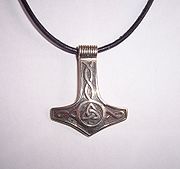
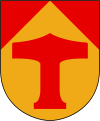
Germanic Neopaganism
Germanic neopaganism is the contemporary revival of historical Germanic paganism. Precursor movements appeared in the early 20th century in Germany and Austria. A second wave of revival began in the early 1970s...
faiths wear Mjöllnir pendants as a symbol of that faith worldwide. Renditions of Mjöllnir are designed, crafted and sold by some Germanic Neopagan groups and individuals. Some controversy has occurred concerning the potential recognition of the symbol as a religious symbol by the United States government.
Outside of Germanic Neopaganism, depictions of Mjöllnir are used in Scandinavian logos and iconography, such as the Mjöllnir logo of the Bornholm Museum
Bornholm Museum
The Bornholm Museum is a museum located in Rønne, Bornholm, Denmark. The museum gives a history of Rønne and the island of Bornholm, dating from the Paleolithic era to the modern age, including the history of occupied Bornholm during World War II...
in Denmark and the coat of arms for Torsås Municipality
Torsås Municipality
Torsås Municipality is the southernmost municipality of Kalmar County, Sweden. Its seat is located in the town Torsås.The present municipality was created in 1971, when "old" Torsås was merged with Söderåkra....
, Sweden. Mjöllnir pendants are popular in general in Scandinavia and can be seen elsewhere in heavy metal
Heavy metal music
Heavy metal is a genre of rock music that developed in the late 1960s and early 1970s, largely in the Midlands of the United Kingdom and the United States...
(especially Black metal
Black metal
Black metal is an extreme subgenre of heavy metal music. Common traits include fast tempos, shrieked vocals, highly distorted guitars played with tremolo picking, blast beat drumming, raw recording, and unconventional song structure....
and Viking metal
Viking metal
Viking metal is a subgenre of heavy metal music characterized by its galloping pace, keyboard-rich anthemic sound, bleakness and dramatic emphasis on lyrical themes of Norse mythology, Norse paganism, and the Viking Age...
) and "Dark" subculture
Subculture
In sociology, anthropology and cultural studies, a subculture is a group of people with a culture which differentiates them from the larger culture to which they belong.- Definition :...
s, and, to a lesser extent, among Rockers
Rocker (subculture)
Rockers, leather boys or ton-up boys are a biker subculture that originated in the United Kingdom during the 1950s. It was mainly centered around British cafe racer motorcycles and rock and roll music....
and biker
Motorcycling
Motorcycling is the act of riding a motorcycle. A variety of subcultures and lifestyles have been built up around motorcycling.-Benefits:Robert M. Pirsig's book Zen and the Art of Motorcycle Maintenance was a paean celebrating motorcycling...
subcultures. Also Mjolnir is the name of the armor that Master Chief wears in the Halo series.
See also
- Battle Axe culture
- BracteateBracteateA bracteate is a flat, thin, single-sided gold medal worn as jewelry that was produced in Northern Europe predominantly during the Migration Period of the Germanic Iron Age...
- Donar's oak
- Hercules' Club (amulet)Hercules' Club (amulet)Hercules' Club is a Roman Empire and Migration era artefact type.Roman era Hercules's Clubs appear from the 2nd to 3rd century, spread over the empire Hercules' Club (also Hercules-club, Club-of-Hercules; German ) is a Roman Empire and Migration era artefact type.Roman era Hercules's Clubs...
- Axe of PerunAxe of PerunThe Axe of Perun was the axe wielded by the Slavic god of thunder and lightning, Perun....
- UkonvasaraUkonvasaraUkonvasara or Ukonkirves is the symbol and magical weapon of the Finnish thunder god Ukko, and was similar to Thor's Mjolnir. Ukonvasara means hammer of Ukko and ukonkirves means axe of Ukko. With Ukonvasara, Ukko created lightning...
- IrminsulIrminsulAn Irminsul was a kind of pillar which is attested as playing an important role in the Germanic paganism of the Saxon people. The oldest chronicle describing an Irminsul refers to it as a tree trunk erected in the open air...
- LabrysLabrysLabrys is the term for a symmetrical doubleheaded axe originally from Crete in Greece, one of the oldest symbols of Greek civilization; to the Romans, it was known as a bipennis....
- VajraVajraVajra is a Sanskrit word meaning both thunderbolt and diamond...
- List of mythological objects
- Sun crossSun crossThe sun cross, also known as the wheel cross, Odin's cross, or Woden's cross, a cross inside a circle, is a common symbol in artifacts of the Americas and Prehistoric Europe, particularly during the Neolithic to Bronze Age periods.-Stone Age:...
- Mjolnir (Marvel Comics)

